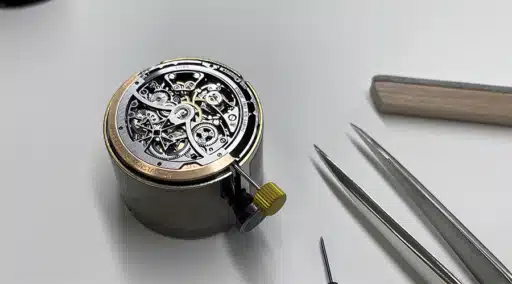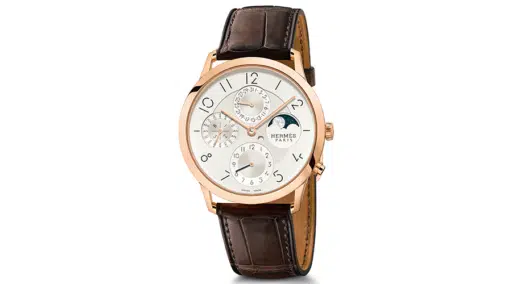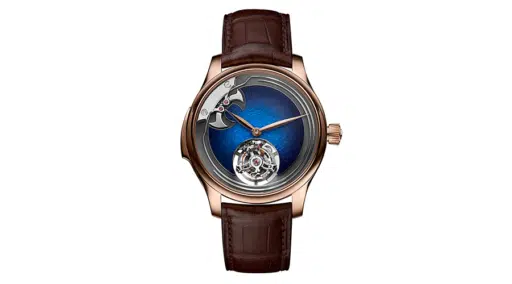Everything You Need to Know About Tourbillon Watches
While tourbillons are hypnotic and beautiful, they can also be confusing. This article answers all of your questions about tourbillon watches.
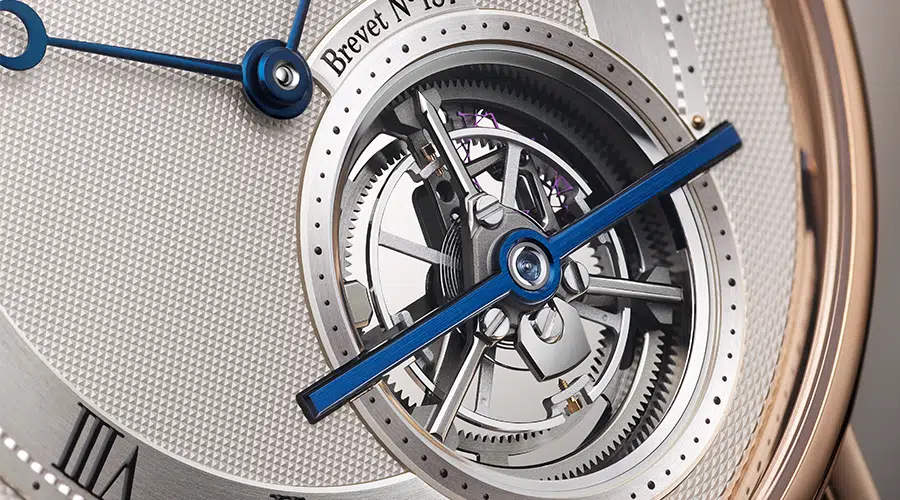
Tourbillons are among the most sought-after complications in watches. Watch movements are typically hidden beneath watch dials, and even in skeletonized or openworked watches that show the movement, there’s not much movement happening. On the other hand, tourbillons show the watch’s beating heart — the balance wheel — and make a 360-degree turn every minute. They’re fascinating to look at. This article explains everything you need to know about tourbillons, including why they were invented, whether they’re still relevant today, and who makes the most incredible luxury tourbillon watches.
Who Invented the Tourbillon?
Abraham-Louis Breguet invented the tourbillon and patented the mechanism on June 26, 1801. He sold his first pocket watch with a tourbillon in 1805 and debuted it publicly in Paris in 1806.
What Does a Tourbillon Do?
A tourbillon makes a watch more accurate by counteracting the negative effects of gravity on the movement. Breguet invented the tourbillon during the age of the pocket watch. Pocket watches were frequently kept in a vertical position in a pocket for a long period of time. This meant gravity would pull down on the balance spring. In addition, gravity has less of an effect on the movement in certain positions. This is called positional error.
Keeping a watch in a single position can create a domino effect in the movement that affects its accuracy. The balance spring controls the speed of the balance wheel, which controls the speed of the hour and minute hands. Gravity pulling on the balance spring for too long can slow the balance wheel, which slows timekeeping. A tourbillon counters the negative effects of gravity by rotating the balance wheel so gravity can’t pull on it.
How Does a Tourbillon Work?
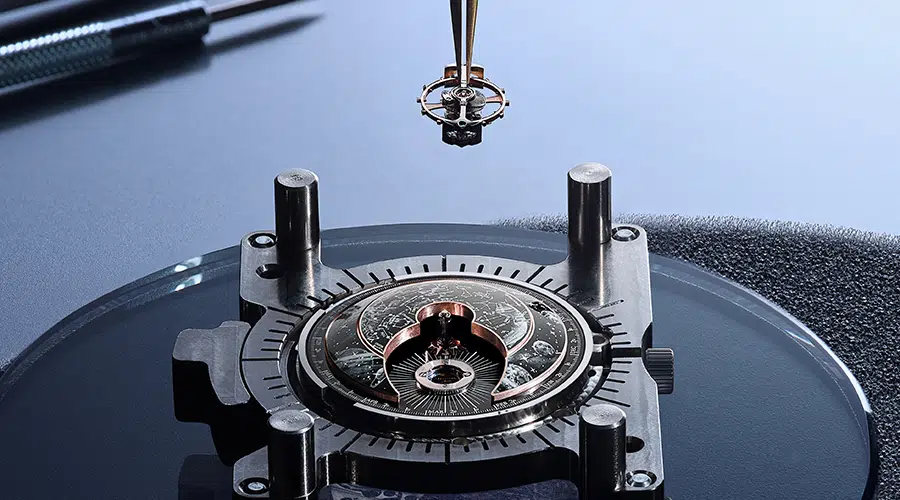
A tourbillon cage encloses and rotates the balance wheel, balance spring, and escapement 360 degrees. By rotating the balance wheel and balance spring 360 degrees regardless of the watch’s position, gravity can’t pull on the delicate spring in the same way and slow down the movement. This 360-degree movement also creates a balance between slow and fast positions, negating gravity’s influence. A tourbillon typically makes a full rotation every 60 seconds. For this reason, many tourbillons also indicate the seconds instead of having a central seconds hand or a seconds subdial.
A tourbillon is absolutely hypnotic to watch. It’s a delicate dance of the rotating cage and the rapidly oscillating balance wheel. Tourbillon watches typically have apertures or are fully skeletonized to display the tourbillon dial side so you can enjoy its mesmerizing motion all the time.
Is a Tourbillon a Complication?
Ah, one of the great debates in watchmaking. A complication is any function added to a watch other than the display of the hours, minutes, and seconds. Since a tourbillon improves accuracy but does not add another function, it is not a complication according to that definition. However, many in the watch world consider a tourbillon to be a complication because it is difficult to create and is not a necessary part of a movement.
Is a Tourbillon Necessary?
Today, instead of pocket watches, we wear wristwatches that are in near-constant motion in many different positions, so tourbillons aren’t needed to maintain accuracy. However, they are beautiful to watch and a wonderful expression of a watchmaker’s technical ability.
What Does Tourbillon Mean?
Tourbillon is the French word for “whirlwind.” It poetically describes the frenetic motion of the rotating cage and oscillating balance wheel.
What Are the Different Types of Tourbillons?
A traditional tourbillon is mounted with a bridge that connects it to the movement on both sides. The flying tourbillon was invented in 1920 by Alfred Helwig, a master watchmaker at Glashütte Original. A flying tourbillon is mounted from the bottom, so it appears to be unconnected, hovering within the movement. Of course, watchmakers love to challenge themselves and set new records. Some brands have multi-axis tourbillons that spin in multiple directions at once. Others include multiple tourbillons in a watch. At first glance, an open-heart watch that displays the oscillating balance wheel might look like a tourbillon. However, if the balance wheel is only moving back and forth and not rotating, it’s not a tourbillon.
Breguet Classique Tourbillon Extra-Plat Anniversaire 5365
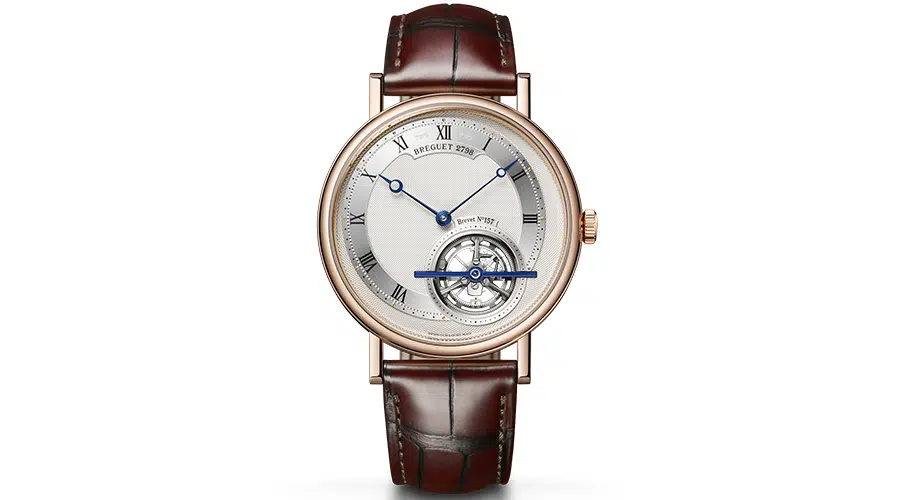
Since its founder invented the tourbillon, it’s no surprise that Breguet remains a master of tourbillon watches. The Classique Tourbillon Extra-Plat Anniversaire 5365 celebrates the 220th anniversary of the invention of the tourbillon. While it has the classic stylings of a dress watch, its slightly off-center chapter ring and tourbillon placement at 5 o’clock add a bit of an unexpected twist. The tourbillon’s upper bridge is crafted from blued steel that matches the blued Breguet hands. The words “Brevet No 157” appear above the tourbillon in honor of Breguet’s original patent number for the invention of the tourbillon. In the center of the chapter ring, there’s a beautiful example of another Breguet hallmark, guilloché. The watch features a Clous de Paris guilloché motif that is created by hand. Outside of the chapter ring, there’s a barley grain guilloché motif. The watch is limited to 35 pieces in honor of the 35 tourbillon timepieces that Abraham-Louis Breguet created.
Greubel Forsey Tourbillon 24 Secondes Architecture

Greubel Forsey is known for its extremely complicated, mind-bending watches. They’re so intricate that it can take you a few minutes — or longer — to wrap your head around the timepiece. The new Tourbillon 24 Secondes Architecture invites you to get lost inside the movement, thanks to its unique open design. The unusually shaped convex titanium case measures 47.07mm by 16.80mm, which is certainly hefty, but Greubel Forsey has never been concerned with thinness. It uses this space judiciously to showcase its truly impeccable finishes and technically advanced movement. Even the case band (side of the case) is crafted from sapphire glass, so you can see the movement from as many angles as possible.
The star of the show is the brand’s famous 24-second tourbillon, located at 6 o’clock. Not only does this tourbillon rotate more quickly than the standard 60-second tourbillon; it’s also set at a 25-degree angle. It’s suspended by a titanium bridge, which is polished to such a mirror-like sheen that you can actually see yourself reflected in it.
While you will inevitably be drawn to the tourbillon, there’s plenty more to admire in the sculptural movement. At 8 o’clock, a small raised dial shows the seconds; there’s a 90-hour power-reserve indicator at 3 o’clock; and the polished barrel bridge and engraved barrel cover are located at 10 o’clock.
Jaeger-LeCoultre Master Grande Tradition Calibre 948
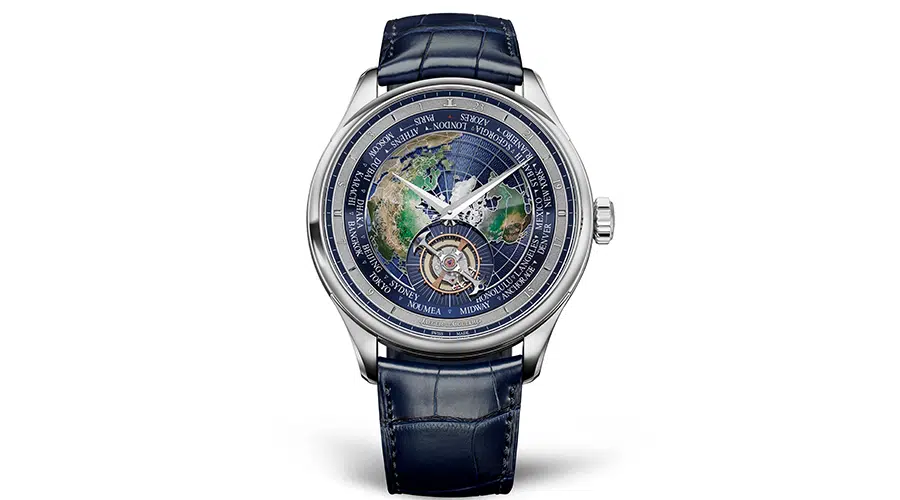
Swiss watch brand Jaeger-LeCoultre crafts extremely complicated tourbillon timepieces, including its famed gyrotourbillon, a multi-axis tourbillon that rotates in two planes simultaneously. It has to be seen to be believed, so check out this video to see it in action. Jaeger-LeCoultre also pairs tourbillons with other high complications, including chiming watches and a new world timer. The Master Grande Tradition Calibre 948 pairs a world-time complication with a flying tourbillon — the first time these complications have ever been combined. World-time watches show the time in all 24 main time zones simultaneously. In most world-time watches, a 24-hour disk rotates every 24 hours around a fixed city disk. Jaeger-LeCoultre uses a similar concept, but it has the map and the tourbillon rotate inside the fixed city and hour disks. The map and the tourbillon make a full circuit around the dial every day.
The brand also uses this watch as a canvas for its métiers d’art. The dial features an aerial view of Earth as seen from the North Pole. The map floats atop a grid of longitude and latitude lines. This beautiful map is crafted from champlevé enamel. Artisans carve the outlines of the continents in a piece of precious metal, then fill the centers with colored enamel. The enamel process itself takes 55 hours of work.
Audemars Piguet Code 11.59 Selfwinding Flying Tourbillon Chronograph
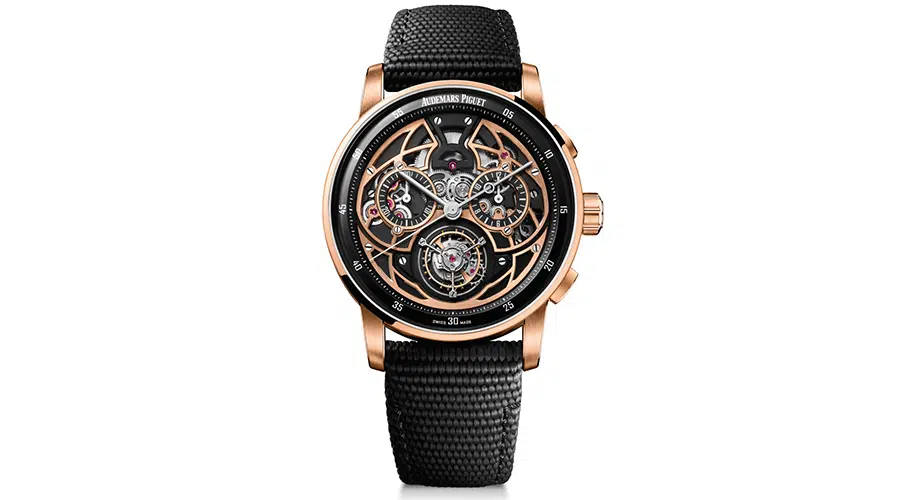
The moody Code 11.59 Selfwinding Flying Tourbillon Chronograph from Audemars Piguet combines a flying tourbillon with a flyback chronograph — a unique combination. The watch pairs black ceramic with 18K pink gold in the case and the openworked, architectural movement. The flying tourbillon is at 6 o’clock, where it hypnotically rotates. The transparent chronograph counters are near 3 and 9 o’clock but slightly more central to accommodate the geometric pattern created by the bridges. This isn’t a typical chronograph; it’s the more impressive flyback chronograph. Instead of resetting and restarting the movement with multiple pushes, the chronograph hand flies back to zero and restarts instantly with a single push. Combining two “flying” complications is charming. The automatic watch has a 65-hour power reserve and a skeletonized 18K pink gold rotor that shows more of the movement from the back. Audemars Piguet highlights its craftsmanship and finishing in this watch. The brand notes the movement has 111 V-angles that are impeccably finished with sandblasting, satin-finishing, and hand-polishing.
Chanel J12 Diamond Tourbillon
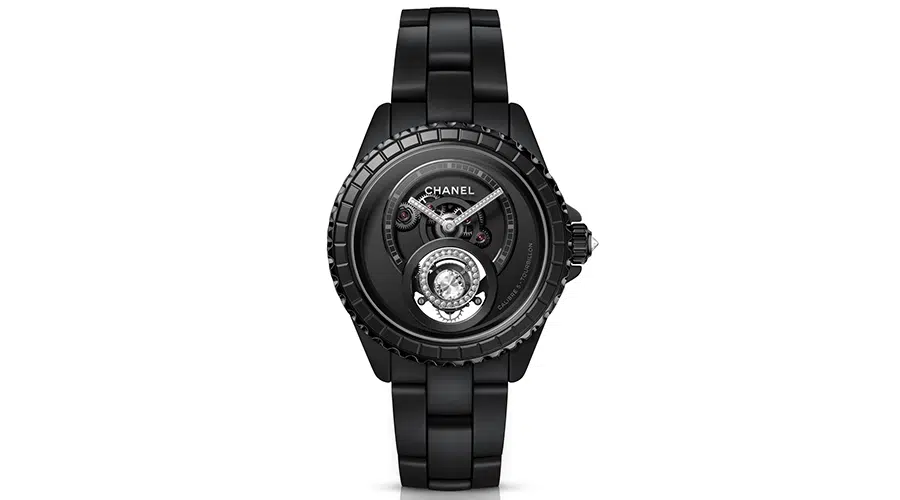
Chanel continues to expand its mechanical watch universe with unique twists on high horology. In the J12 Diamond Tourbillon, it unveils its first in-house flying tourbillon. While a flying tourbillon on its own is quite impressive, Chanel adds another layer of complexity by placing a diamond in the center of the flying tourbillon cage. As the diamond turns, it sparkles from all angles. The cage and the hands are set with 49 additional diamonds, which contrast brilliantly with the matte black ceramic case and bracelet.
Bulgari Octo Finissimo Tourbillon Chronograph Skeleton
Automatic

In the past decade, Bulgari has cemented its place in the world of ultra-thin watches by setting a record seemingly every year. The Octo Finissimo Tourbillon Chronograph Skeleton Automatic holds the record for being the thinnest tourbillon movement with a chronograph, clocking in at 3.5mm thick. In comparison, the Audemars Piguet Code 11.59 Selfwinding Flying Tourbillon Chronograph measures 13.8mm thick to accommodate the flying tourbillon and the flyback chronograph. Sure, it’s a very specific record, but this Bulgari watch combines three impressive feats within a very slim space: a rotor to power the watch, a chronograph, and a tourbillon. To achieve this, the movement uses a peripheral rotor. This is a slim rotor that, as its name suggests, rotates around the outer ring of the movement instead of above it. The skeletonized watch has two chronograph counters, at 3 and 9 o’clock. Despite having two pushers, the chronograph is actually a monopusher activated by the pusher at 2 o’clock. The pusher at 4 o’clock changes the crown function.
Harry Winston Histoire de Tourbillon 10
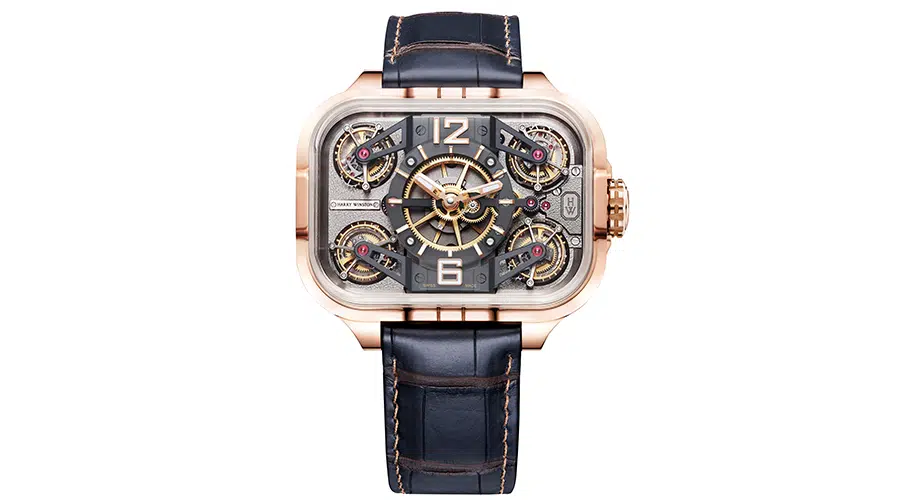
For a decade, Harry Winston meditated on the tourbillon in its Histoire de Tourbillon collection. It released 10 impressive tourbillon watches, each pushing the boundaries of watchmaking. While you might not expect technically impressive pieces from a house best known for its dazzling diamond jewelry, Harry Winston certainly showed it deserved a place in high horology through its Histoire de Tourbillon and Opus collections. The Histoire de Tourbillon collection ended with its 10th edition, and while it’s no longer available, it’s well worth including in this feature. This 53.3mm rectangular watch has four independent tourbillons, one in each corner. It’s not the first wristwatch with four tourbillons, but it’s the first to be produced as a series, according to the brand. The tourbillons rotate more quickly than most 60-second tourbillons, making a full circle every 36 seconds. The tourbillon bridges lead to the middle of the watch, where there’s a small chapter ring for the hours and two large numerals at 12 and 6 o’clock. This unique piece is made from a proprietary alloy called Winstonium, but the house also made 20 pieces in white and red gold. Now that Harry Winston has closed the chapter on its Histoire de Tourbillon watches, we look forward to seeing how it pushes the boundaries of watchmaking next.
Kross Studio Lotus Tourbillon
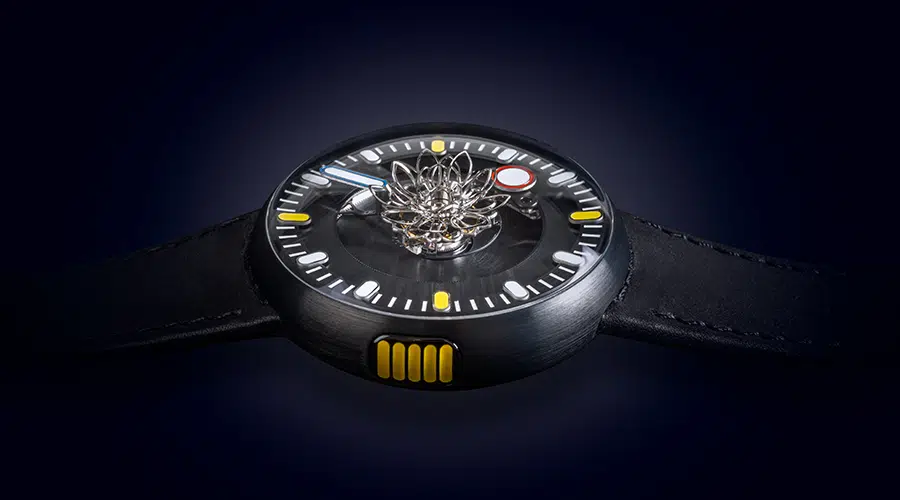
Kross Studio adds artistic flair to the tourbillon in its unusual Lotus tourbillon watch. The avant-garde Swiss watchmaker is known for its collaborations, including with entertainment behemoths Lucasfilm and Warner Brothers. In this piece, it collaborated with designer Alain Silberstein. Many watches put the tourbillon at 6 o’clock, but Kross Studio places it in the center of the dial, topping it with a skeletonized lotus flower. The titanium lotus flower obscures the oscillating balance wheel, but the flower itself rotates. Instead of central hour and minute hands, the watch has short hands on the periphery. The 45mm watch has a domed sapphire glass to accommodate the height of the lotus flower. Instead of a crown, the watch uses a D ring winder integrated into the caseback and a slim pusher at 3 o’clock to set the time. The aesthetics of this watch are interesting. Kross Studio is known for its geometric designs, which really stand out in the watch world, where classic or more industrial looks are the standard. We don’t see many playful, cartoonish watches.



